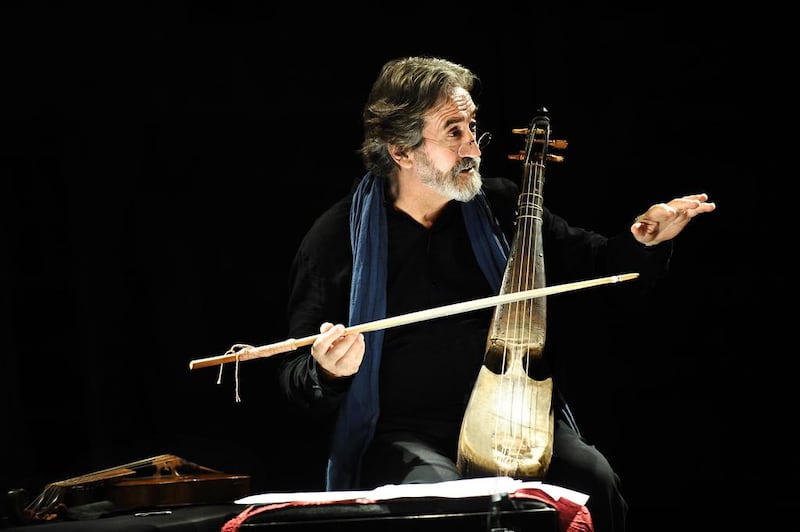Only a true talent could become famous for playing an instrument hardly anyone’s ever heard of. The Spanish musician, conductor and composer Jordi Savall, making his Abu Dhabi debut this week, is one of the rare figures who has managed this feat. He is known as probably the world’s greatest player of the viol – no, not the violin, but a lighter, quieter cousin popular during the baroque era. Subtle but powerful, the viol is one of those great instruments that for years seemed to have fallen through the cracks of music history. Classical music is actually a treasure chest for these wonderful, overlooked instruments – with incredible music to match. Here are a few to look out for.
Marimba
Is it a xylophone or a synthesizer? The marimba's sound is so resonant and strange it can come across as electronic. It's actually made from striking hollowed-out rosewood bars, creating a metallic buzz thanks to aluminium resonators dangling beneath. While the marimba is seldom played globally, calling it rare in Central America would get you laughed at. The instrument is so common in its region of origin that every second bar has someone tunefully clanging away on one. In the 20th century, the marimba left Mexico when classical composers cottoned on to its full, meaty sound. To hear it used to brilliant effect, look out for the 1920s darling Darius Milhaud's playful Latin American-inspired Concerto for Marimba and Vibraphone.
Cor Anglais
The cor Anglais could be the classical orchestra's most misnamed instrument. Despite its name ("cor" is French for horn) it's neither English nor a horn, but a longer, deeper-pitched big sister to the oboe. Its rich sound crops up often in the western repertoire, but it all-too rarely gets a chance to take centre stage. It deserves more exposure, as it makes a powerful but enchantingly mellow sound that comes across like the far-off honk of some exotic bird. Jean Sibelius recognised this when he gave it the lead solo in his magical, if bleak, symphonic poem The Swan of Tuonela, about a legendary swan that swims around the island of the dead in Finnish mythology.
Celesta
Tinkling and pretty in a slightly unsettling, clock-chime kind of a way, the sound of the celesta is probably the most ethereal to come from any keyboard instrument. Invented in 19th-century France, the celesta sounds like a delicate glockenspiel – no coincidence, as its piano-like casing hides unmuffled metal hammers that strike each note. You've probably heard its sound already – it's the solo instrument in Tchaikovsky's Dance of the Sugar Plum Fairy from The Nutcracker Suite. It is used to more jarring, spooky effect in Béla Bartók's Music for Strings, Percussion and Celesta, a modernist classic used several times in horror-film scores.
Theremin
With its hands-off playing style and quavering organ-like note, the theremin is part musical instrument, part magic trick. Invented in Russia in the 1920s, this pioneering electronic instrument rocked the world between the wars, fascinating audiences both with its electric power source and with the fact that theremin players waved their hands above the instrument without touching it, apparently conjuring music out of the air. Often treated as a novelty, the theremin nonetheless has some beautiful, serious classical music written for it. To hear its potential, check out the early 20th-century Czech composer Bohuslav Martinu's Fantasia for Theremin, Oboe, String Quartet and Piano, where its vibrato sound, somewhere between a violin and a recorder, is employed to tuneful, melancholic effect.
Basset horn
Yes, it’s another fake horn. The basset is really a kind of clarinet, one of those “what if?” instruments that was very popular, then all but disappeared. Could this be because the sharp bend in the original model’s neck made it look ungainly, like a broken walking stick? Modern versions look a little less weird, with a metal bell like a saxophone – the basset actually sounds somewhat like a woodier version of the saxophone. Quite why this strange beauty fell from favour is a mystery – both Mozart and Mendelssohn were fans and made some great music for it. Some of this has made its way onto disc – look out for Trio Chalumeau’s attractive collection of all Mozart’s chamber music for basset horn.
Jordi Savall performs with the ancient music ensemble Herspèrion XXI for the world premiere of Ibn Battuta: The Voyager of Islam I. From Morocco to Afghanistan (1314-1336) on Thursday, November 20 at 8pm, Emirates Palace, as part of Abu Dhabi Classics. Tickets start at Dh30 from www.ticketmaster.ae. For more information, visit www.abudhabievents.ae
artslife@thenational.ae





